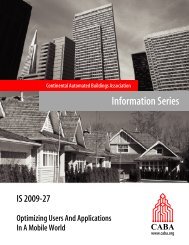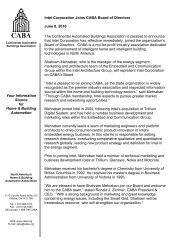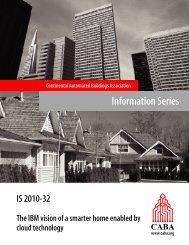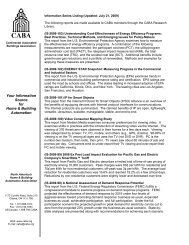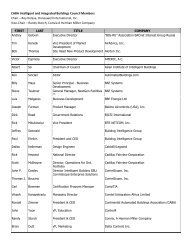Your Information Source for Home & Building Automation
Your Information Source for Home & Building Automation
Your Information Source for Home & Building Automation
Create successful ePaper yourself
Turn your PDF publications into a flip-book with our unique Google optimized e-Paper software.
57<br />
IS-2007-62: When Should I Use a Managed Ethernet Switch<br />
This white paper from Contemporary Controls describes the functions of an Ethernet<br />
switch. First the differences between a hub and an unmanaged switch are explained.<br />
Then the functions possible in a managed switch are listed. A managed switch can<br />
control the data rate delivered to each port. Also, diagnostic tools are available using the<br />
Simple Network Management Protocol (SNMP).<br />
IS-2007-61: The Market Survey of the Energy Industry 2004<br />
The Association of Energy Engineers surveyed 456 association members on the state of<br />
the energy market to help determine a national energy policy and the benefits of energy<br />
management. Energy efficiency and management was judged most important. New<br />
generation sources are needed, global warming must addressed, and investment tax<br />
credits are beneficial. A slim majority thinks that mergers will hurt the energy industry.<br />
The best incentive <strong>for</strong> utilities to encourage energy management is through rebates. This<br />
survey is based on 49 questions. Detailed answers are provided.<br />
IS-2007-60: Technology Contracting: Designing Systems <strong>for</strong> Efficiency and<br />
Interoperability<br />
Johnson Controls reports on the benefits of centralizing responsibility <strong>for</strong> the<br />
management of building automation systems through technology contracting. Instead of<br />
subcontracting HVAC, lighting, security, IT networking, etc. to separate companies with<br />
separate responsibilities, an overall manager is assigned. This is particularly useful when<br />
the building systems are integrated. This approach saves time, reduces risk and blame,<br />
cuts capital costs, reduces construction costs, cuts operating costs, and enables system<br />
interoperability. The process <strong>for</strong> technology contracting is described with a few examples.<br />
IS-2007-59: Wireless Consumer and Business User Profiles<br />
ABI Research conducted a survey among 1,223 cell phone users across the U.S. Results<br />
of the survey are reported in the following categories: cell phone brands, monthly usage,<br />
cell phone features including multimedia, Bluetooth, and Wi-Fi access. Business users of<br />
cell phone voice services spend 19 per cent more on voice and 80 per cent more on data<br />
than consumers. Twenty-four per cent would like Internet access on their cell phones.<br />
Femtocells extend cell phone service via a broadband connection into buildings and<br />
homes where service might have been poor. Seventy-two per cent were not interested in<br />
this service. About one-third of business users would add a cellular modem to their laptop<br />
<strong>for</strong> Internet access via cell phone service.<br />
IS-2007-58: National Action Plan <strong>for</strong> Energy Efficiency<br />
The US Department of Energy and the Environmental Protection Agency organized a<br />
study on improving energy efficiency in homes, buildings, schools, governments, and<br />
industry. Recommendations were developed <strong>for</strong> utilities, regulators, and partner<br />
organizations. Demand <strong>for</strong> energy is expected to increase 30 to 40 per cent <strong>for</strong> electricity<br />
by 2030. Energy efficiency programs could eliminate the need <strong>for</strong> 40 new 500-MW plants<br />
over the next 10 to 12 years. Among the recommendations in this extensive report are<br />
policy changes through rate designs to move utilities towards energy efficiency.<br />
IS-2007-57: The Cost-Effectiveness of Commercial-<strong>Building</strong>s Commissioning<br />
This research report issued by the Lawrence Berkeley National Laboratory describes a<br />
process of building commissioning to detect and remedy problems. Such problems<br />
include design flaws, construction defects, equipment problems, and needed<br />
maintenance. A methodology was developed based on analyzing 224 buildings. HVAC<br />
presented the most problems. New buildings have three times the defects of existing<br />
buildings. System-level interactions were tested. Problems were found in valves, filters,<br />
controls, etc. Non-energy benefits include improved equipment lifetime, productivity, and<br />
indoor-air quality. Detailed data and charts are included.



